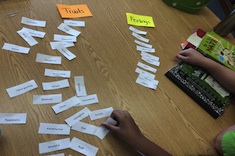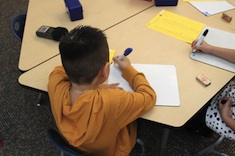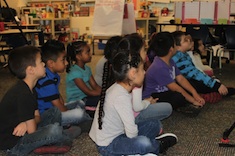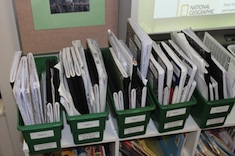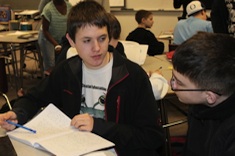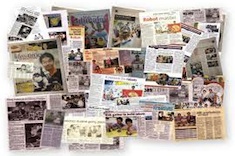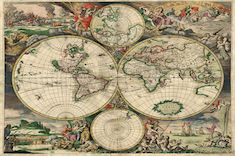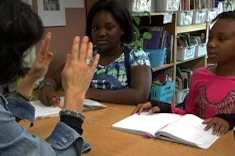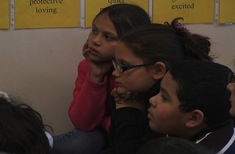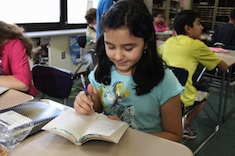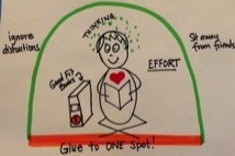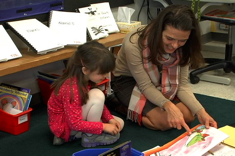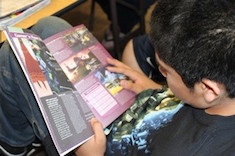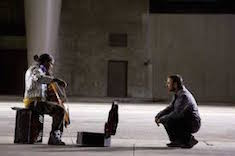Teaching Reading
Our contributors lead reading workshops in classrooms with creative flair. Over the past 12 years, we've filled our site with loads of suggestions, tools, and tips for using engaging books throughout the curriculum to hook kids on reading. Here is where you will find many stories of successful and not-so-successful workshop days, and what we learned from them. We bring these stories to life through hundreds of video examples.
Latest Content
Modeling Nonfiction Writing for English Language Learners: Part 3
Stella Villaba models nonfiction writing for her first- and second-grade English language learners, and in the process integrates vocabulary instruction into her lesson. This is the final video in a three-part series.
The Case for the Sonnet
Gretchen Schroeder makes a case for teaching the sonnet to teenagers in the age of texts and Twitter.
Character Traits Through Word Sorts
Melanie Swider finds word sorts are a great way to help intermediate students master new vocabulary for describing character traits.
Learning Vocabulary in Context with English Language Learners
Stella Villalba explores why it is so important to teach vocabulary to English language learners in context.
Read Alouds and Standards
Maria Caplin explains how read alouds do double duty in her fifth-grade classroom, as they help build a love for story and help students master key literacy and content area standards.
Shared Reading in the Digital Age
Shari Frost finds that shared reading routines are easier to implement now because of tech tools.
Slow Down
Gretchen Schroeder has three strategies for slowing down with her high school students and savoring literacy learning.
Planning and the Tuesday Effect
Mary Lee Hahn realizes how much a workshop approach has changed her planning process and comfort level with the unexpected.
Wonder and React
How do you scaffold students for independent work? Melanie Meehan finds Wonder and React is a great strategy to use with fifth graders during an information writing unit.
Growing Toward Independence
Cathy Mere shares what to look for and what to try next with young learners who are easily distracted and struggling to concentrate during independent reading.
The Compliment Conference
Katrina Edwards confers with Camilla, a struggling reader. She is a child who has no confidence in herself. The Compliment Conference is a way to acknowledge and build upon Camilla’s strengths, and boost her self-esteem at the same time.
Time for What Matters
Gretchen Schroeder has only 42 minutes with her high school students each day. She explains how she establishes priorities.
Kindergarten Reading Conference: Building Confidence
Mandy Robek finds that kindergartner Mikey is lost in knowing how to use his time well during reading workshop. Her conference moves him from deflated to inspired.
Extended Inquiry with Article of the Week
Gretchen Schroeder finds the article of the week activity is an excellent vehicle for learning about content literacy gaps in student background knowledge and how to fill them.
The Intersection of Social Studies and Language Arts
Melanie Meehan writes about how teachers in her state are dealing with the time-crunch issue in social studies instruction by naturally integrating more social studies into the language arts program.
Understanding Character Traits: Part 3
Jason DiCarlo completes his lesson on character traits in third grade. This is the final installment in a three-part series.
Owl Research Brainstorming: Partner Work
Andrea Smith’s fourth graders are working on an Owl Research project that integrates reading, writing, talking, listening, and content literacy.
Understanding Character Traits: Part 2
Jason DiCarlo continues his third-grade reading workshop lesson on character traits with a mentor text. This is the second video in a three-part series.
Getting Mentor Texts in Students’ Hands
Jillian Heise discovers that her students need more access to the mentor texts she reads aloud, so she develops strategies to get them to students.
Alternatives to Home/School Reading Logs
There may be few literacy homework assignments more despised by families than the dreaded reading log. Gigi McAllister proposes some alternatives, and explains how she keeps families in the loop on reading progress.
Stamina Bubbles
“Why do you always say ‘Happy reading!’ to us?” This question from a first grader leads Katrina Edwards to develop visual support tools for building stamina during reading workshops.
Conferring with Jeri in Kindergarten
Mandy Robek demonstrates the strategies of teach, prompt, and reinforce when conferring with kindergartner Jeri.
Back to Basics: Choice
Ruth Ayres explores the boundaries of student options in writing workshops.
Reading Pictures in High School
Gretchen Schroeder melds famous artwork with literacy instruction in her high school classroom.
Using Webcomics in Classrooms
Katherine Sokolowski explains why she uses webcomics in her literacy workshops, and shares an extensive list of her favorite online sources.
Visual Reading for Writing
Carly Ulmer uses visual literacy to build writing skills with her seventh graders through two powerful minilessons.
Close Reading for Comparison in Fifth Grade
Katherine Sokolowski uses a fascinating picture book to build close reading skills with her fifth graders. The key is selecting a text that holds up well through multiple readings.
Beginning a Novel with Close Reading
Aimee Buckner helps a fourth-grade boy tease out emerging themes in the first pages of the novel Morning Girl.
“Are We Gonna Watch the Movie?”
Gretchen Schroeder finds her high school students are always eager to see the movies related to the novels they are reading in class. Yet it rarely makes sense to show the entire film. She explains how to choose clips judiciously.
Embracing Standards in Creative Ways
Christy Rush-Levine makes links between standards, video clips, and close reading.
Browse Content By
Type
Category
- Assessment Tools
- Big Fresh Archives
- Booklists
- Choice Numeracy
- Classroom Design
- Common Core
- Community Building
- Conferring
- Content Literacy
- Digital Literacy
- English Language Learners
- Equity
- Family Relations
- Free Samples
- Guiding Groups
- Leadership
- Literacy Coaches
- Mentor Texts
- Minilessons
- New Teacher Mentors
- Podcasts
- Poetry
- Quote Collections
- Reading Strategies
- Self Care
- Struggling and Striving Learners
- Talking and Listening
- Teacher Study Groups
- Teaching Reading
- Teaching Writing
- Word Study and Vocabulary
Author
- Melissa Quimby
- Nawal Qarooni
- Gwen Blumberg
- Julie Cox
- The Lead Learners
- Hannah Tills
- Josie Stewart
- Ruth Metcalfe
- Mallory Messenger
- Becca Burk
- Jodie Bailey
- Vivian Chen
- Mary Brower
- Tiffany Abbott Fuller
- Stephanie Affinito
- Ruth Ayres
- Leigh Anne Eck
- Heather Fisher
- Shari Frost
- Julie Johnson
- Suzy Kaback
- Gigi McAllister
- Shirl McPhillips
- Melanie Meehan
- Cathy Mere
- Debbie Miller
- Tara Barnett and Kate Mills
- Tammy Mulligan
- Dana Murphy
- Bitsy Parks
- David Pittman
- Brenda Power
- Heather Rader
- Matt Renwick
- Mandy Robek
- Christy Rush-Levine
- Gretchen Schroeder
- Jen Schwanke
- Brian Sepe
- Katherine Sokolowski
- Stella Villalba
- Jennifer Vincent
Grade Level
Choice Literacy Membership
Articles
Get full access to all Choice Literacy article content
Videos
Get full access to all Choice Literacy video content
Courses
Access Choice Literacy course curriculum and training



